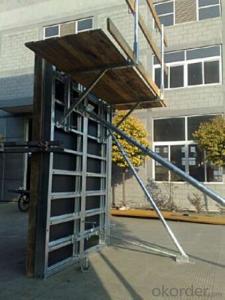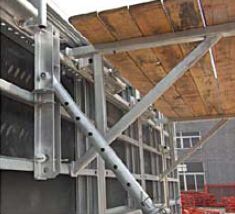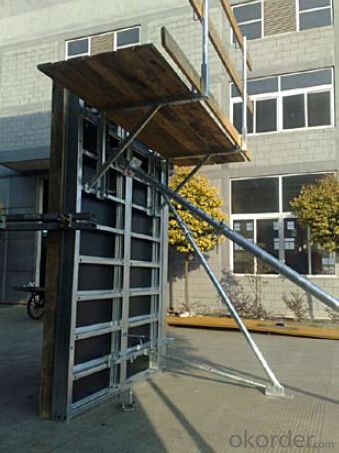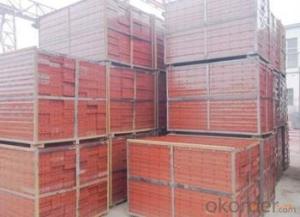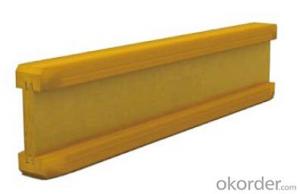Steel-frame Formwork and scaffolding system platform
- Loading Port:
- Tianjin
- Payment Terms:
- TT OR LC
- Min Order Qty:
- 50 m²
- Supply Capability:
- 1000 m²/month
OKorder Service Pledge
OKorder Financial Service
You Might Also Like
Steel-frame Formwork SF-140
Characteristics:
◆ Few parts for fast forming.
◆ Max. Concrete pressure: 80KN/m2.
◆ Hot-dip galvanized steel frame.
◆ The thickness of plywood is 18mm & the panel is 14cm.
◆ Compatibility with Hunnebeck Manto system due to similar edge profile.
System Details & Application:
◆ Neat joint and fast assembling with aligning panel clamp.
◆ Flexible panel arrangement and height extension.
◆ The selection of panels.
◆ Kinds of panel connectors.
◆ Corner clamp application.
◆ Length adjustment application.
◆ Height adjustment & aligning strut.
◆ Walkway bracket & platform.
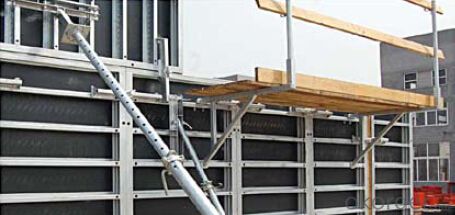

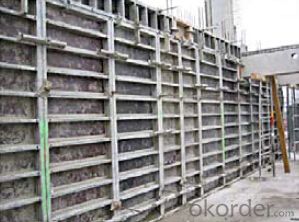

- Q: How does steel formwork handle concrete curing time?
- Concrete curing time is efficiently and effectively managed by steel formwork. Sturdy and durable steel plates are used to construct the formwork, providing excellent support and stability during pouring and curing. The steel plates are specifically designed to withstand the weight and pressure of the wet concrete, ensuring that the formwork remains intact and in position until the concrete is fully cured. This prevents any deformation or collapse of the formwork structure, which could compromise the quality and integrity of the final concrete structure. In addition, the smooth and non-absorbent surface of the steel formwork minimizes moisture loss from the concrete during the curing process. This is crucial as maintaining proper moisture levels is essential for the concrete to achieve optimal strength and durability. Moreover, steel formwork allows for easy and efficient removal once the concrete has cured. The steel plates can be easily dismantled and reassembled for subsequent concrete pours, reducing overall construction time and cost. In summary, steel formwork offers a dependable and robust solution for managing concrete curing time. It ensures the structural integrity of the formwork during curing, maintains appropriate moisture levels for optimal concrete strength, and allows for efficient removal once the concrete is fully cured.
- Q: What are the safety precautions when working with steel formwork?
- When working with steel formwork, it is important to follow certain safety precautions to ensure the well-being of the workers. These precautions include: 1. Proper training: All workers should receive comprehensive training on the correct usage of steel formwork. This includes understanding the assembly, disassembly, and handling of the formwork system. Workers should also be trained on how to identify any potential hazards or risks associated with the steel formwork. 2. Personal Protective Equipment (PPE): Workers should always wear the appropriate PPE. This typically includes safety helmets, steel-toed boots, high-visibility vests, and gloves. In some cases, additional PPE such as safety glasses or respiratory protection may be required, depending on the specific tasks involved. 3. Secure and stable installation: It is crucial to ensure that the steel formwork is securely and stably installed before any work begins. This involves proper anchoring and bracing to prevent any movement or collapse during use. Regular checks should be conducted to verify the stability of the formwork throughout the duration of the project. 4. Safe access and egress: Workers should have safe and clear access to the steel formwork. This may involve the installation of secure ladders, platforms, or scaffolding to provide a stable and safe means of reaching the formwork. Adequate lighting should also be provided to ensure visibility and prevent accidents. 5. Regular inspections: Regular inspections of the steel formwork should be conducted to identify and address any signs of wear, damage, or deterioration. This includes checking for any bent or damaged components, loose connections, or signs of corrosion. Any issues should be addressed promptly to maintain the integrity and safety of the formwork. 6. Proper lifting and handling techniques: When moving or lifting steel formwork components, workers should use proper lifting techniques and equipment. This may involve the use of cranes, hoists, or forklifts, depending on the size and weight of the components. Adequate training and supervision should be provided to ensure safe lifting practices are followed. 7. Clear communication: Effective communication among workers is essential when working with steel formwork. This includes using hand signals, radios, or other communication devices to relay important information or warnings. Clear signage and barriers should also be used to indicate any restricted areas or potential hazards. By following these safety precautions when working with steel formwork, the risk of accidents, injuries, or structural failures can be significantly reduced, creating a safer working environment for all involved.
- Q: How does steel formwork affect the overall thermal insulation of a structure?
- Steel formwork does not have any significant effect on the overall thermal insulation of a structure. The thermal insulation properties of a building primarily depend on the materials used for insulation, such as foam boards, fiberglass, or mineral wool. Steel formwork is mainly used for structural support and shaping concrete during construction and does not contribute to the insulation properties of the structure.
- Q: What are the different types of supports used in steel formwork installation?
- Steel formwork installation commonly utilizes various types of supports to ensure stability and structural integrity. These supports are crucial for the formwork system, offering the following options: 1. Adjustable Props: These props effectively bear the weight of the formwork system and can be easily adjusted to the desired height. They provide stability during concrete pouring and curing. 2. Scaffolding: Frequently employed in steel formwork installation, scaffolding serves as a stable platform for workers. It allows easy assembly and disassembly, making it highly adaptable to different construction projects. 3. Beams and Girders: These horizontal supports distribute load evenly, preventing excessive deflection or deformation of the steel formwork. 4. Bracing: To maintain stability during concrete pouring and curing, diagonal supports known as bracing prevent lateral movement and secure the formwork in place. 5. Anchors and Tie Rods: Anchors and tie rods secure the formwork system to the existing structure, providing additional support and preventing movement or displacement during concrete pouring. 6. Wall Ties: Wall ties hold the formwork panels together, offering lateral support. Typically made of steel, they withstand concrete pressure during pouring and curing. 7. Wedges and Clamps: Wedges and clamps ensure a secure fit of the formwork panels, preventing concrete leakage during pouring. The appropriate selection of support for steel formwork installation depends on factors like structure size, complexity, load-bearing capacity, and site conditions. It is crucial to carefully consider these factors to ensure a safe and efficient formwork installation process.
- Q: What are the different finishes that can be achieved with steel formwork?
- The desired aesthetic and functional requirements of a project determine the various finishes that can be achieved with steel formwork. 1. To achieve a clean and seamless appearance, smooth surfaces can be created with steel formwork. This finish is commonly preferred for architectural applications and high-end buildings. 2. Textured finishes can be achieved by incorporating patterns, designs, or textures onto the steel formwork or using form liners. These finishes add visual interest and can mimic natural materials like stone, wood, or brick. 3. Exposing the aggregate in the concrete surface creates a rough and textured appearance, showcasing the natural beauty of the aggregates. This finish is often used decoratively in applications like sidewalks, driveways, and patios. 4. By using rubber stamps with steel formwork, stamped finishes with intricate patterns and designs like brick, tile, or stone imprints can be created. These finishes are commonly used to add decorative elements to concrete floors, walls, or pavements. 5. A polished finish can be achieved by grinding and polishing the concrete surface, resulting in a smooth, glossy, and reflective surface. This finish is commonly used in commercial and residential buildings, as well as in high-traffic areas that require durability and low maintenance. In summary, steel formwork offers a versatile and flexible solution for achieving different finishes in concrete construction. The choice of finish depends on specific design requirements, project goals, and desired aesthetic outcomes.
- Q: What are the common challenges faced during steel formwork transportation?
- There are a number of difficulties that can arise during the transportation of steel formwork. One major challenge is the sheer weight and size of the formwork. It can be heavy and bulky, making it tough to handle and transport. Special equipment and vehicles may be necessary to safely move the formwork to its intended destination. Another challenge is the risk of damage or distortion during transportation. It is crucial to transport the steel formwork in a way that prevents any bending, twisting, or scratching. If the formwork is mishandled or not properly secured, it can be damaged, which could impact its performance and durability. The logistics of transportation can also pose challenges. Coordinating the delivery of steel formwork to construction sites can be complex, particularly if multiple projects are happening simultaneously. Careful planning and coordination are required to ensure that the formwork arrives on time and in the right quantities. Furthermore, the terrain and road conditions can create challenges during transportation. If the construction site is located in a remote or hard-to-reach area, transporting the steel formwork can be even more difficult. Poor road conditions, narrow access roads, or steep inclines may necessitate additional measures to ensure safe transportation. Finally, safety is of the utmost importance during the transportation of steel formwork. The weight and size of the formwork can pose risks to the personnel involved in loading, unloading, and securing it. It is essential to follow proper safety protocols and provide adequate training to minimize the risk of accidents or injuries. Overall, the challenges commonly encountered during steel formwork transportation include the weight and size of the formwork, the potential for damage or distortion, the logistics of delivery, the terrain and road conditions, and safety considerations. By effectively addressing these challenges, the transportation process can be carried out smoothly, ensuring that the steel formwork is delivered to construction sites in a timely and safe manner.
- Q: Can steel formwork be used for both symmetrical and asymmetrical concrete elements?
- Yes, steel formwork can be used for both symmetrical and asymmetrical concrete elements. Steel formwork is highly versatile and can be customized to meet the specific requirements of any concrete structure, regardless of its shape or complexity. It offers the advantage of being easily adjustable, allowing for the creation of both symmetrical and asymmetrical shapes. Additionally, steel formwork provides excellent strength and durability, ensuring that it can withstand the pressure exerted by the concrete during the pouring and curing process. This makes it a suitable choice for a wide range of concrete elements, including walls, columns, beams, slabs, and more.
- Q: How does steel formwork handle formwork stripping time?
- Steel formwork is renowned for its durability and strength, characteristics that contribute to its exceptional efficiency in handling formwork stripping time. Unlike traditional wooden formwork, steel formwork has the capacity to endure multiple uses while maintaining its structural integrity. As a result, the stripping time required for steel formwork is significantly reduced when compared to other formwork materials. The rigid construction of steel formwork allows it to bear the weight of concrete and resist deformation during the pouring and curing processes. Consequently, the formwork can be removed more quickly once the concrete has set, as there is less concern about damaging or distorting the formwork. Furthermore, the design of steel formwork incorporates smooth and non-porous surfaces. This characteristic prevents the concrete from bonding with the formwork, facilitating an easier and faster stripping process. Additionally, the smooth surface contributes to a superior finish of the concrete, reducing the need for additional finishing work. Moreover, steel formwork systems often include adjustable features such as adjustable props and modular panels. These features enable easy adjustment and repositioning of the formwork, further enhancing the efficiency of the stripping process. This adaptability allows for faster stripping and reusability of the formwork, resulting in significant time and cost savings. In conclusion, steel formwork excels in managing formwork stripping time due to its durability, strength, and smooth surface. Its ability to withstand multiple uses, resist deformation, and prevent concrete adhesion makes steel formwork highly efficient and time-saving in the construction industry.
- Q: How does steel formwork handle different concrete durability requirements?
- Steel formwork proves to be a flexible and long-lasting option capable of effectively managing diverse concrete durability demands. The concrete's pouring forces and pressures are well withstood thanks to the strength and rigidity of steel. The adaptability of steel formwork is highly remarkable as it can be tailored to fulfill specific durability criteria. Consequently, formwork systems that endure harsh environmental conditions like extreme temperatures, moisture, and chemical exposure can be created. Furthermore, steel formwork can be designed to accommodate different load-bearing requirements, ensuring the stability and security of the structure throughout the concrete casting process and beyond. Furthermore, steel formwork guarantees excellent dimensional stability, a key aspect in achieving accurate and precise concrete finishes. This becomes particularly crucial when constructing structures that demand a high level of aesthetic appeal or intricate architectural designs. Additionally, the reusability of steel formwork sets it apart. Unlike other formwork types, steel can be utilized multiple times, effectively minimizing waste and reducing overall construction costs. Consequently, it emerges as a cost-effective solution for projects with varying concrete durability requirements as the formwork can be easily adjusted and reused for different purposes. In conclusion, steel formwork stands as a dependable and adaptable solution that effectively handles diverse concrete durability requirements. Its strength, customizability, dimensional stability, and reusability render it an ideal choice for a wide range of construction projects, ensuring that the desired durability standards of concrete structures are met.
- Q: Can steel formwork be used for industrial projects?
- Yes, steel formwork can be used for industrial projects. Steel formwork is highly durable and strong, making it suitable for heavy-duty industrial applications. It can withstand high pressure and load, making it ideal for constructing structures like industrial buildings, factories, warehouses, and power plants. Steel formwork is also resistant to weather conditions, chemicals, and corrosion, ensuring its long-lasting performance in industrial environments. Additionally, steel formwork offers flexibility and can be easily customized to meet specific project requirements. Overall, its strength, durability, and adaptability make steel formwork an excellent choice for industrial projects.
Send your message to us
Steel-frame Formwork and scaffolding system platform
- Loading Port:
- Tianjin
- Payment Terms:
- TT OR LC
- Min Order Qty:
- 50 m²
- Supply Capability:
- 1000 m²/month
OKorder Service Pledge
OKorder Financial Service
Similar products
Hot products
Hot Searches
Related keywords

